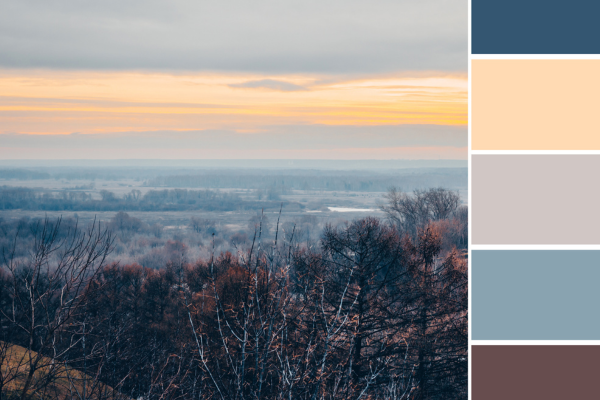Exploring the Color-Emotion Connection in Design
Color is more than just a visual phenomenon—it’s deeply intertwined with human emotions and perceptions. In the world of design, understanding the relationship between color and emotion is essential for creating impactful and resonant experiences. Let’s delve into the fascinating connection between color and emotion and explore how designers can harness this relationship to evoke specific feelings and responses.
- Warm Colors and Emotion: Warm colors, such as reds, oranges, and yellows, are often associated with energy, passion, and warmth. Red, in particular, is known for its ability to evoke strong emotions such as love, excitement, and urgency. It’s no coincidence that red is commonly used in branding to grab attention and convey a sense of vitality. Orange exudes enthusiasm and friendliness, while yellow radiates optimism and happiness. By incorporating warm colors into designs, designers can infuse them with a sense of dynamism and emotion.
- Cool Colors and Emotion: On the other end of the spectrum, cool colors like blues, greens, and purples evoke feelings of calmness, tranquility, and stability. Blue, often associated with the sky and the ocean, symbolizes serenity, trust, and reliability. Green represents nature, growth, and harmony, making it ideal for designs related to health, sustainability, and wellness. Purple, with its regal connotations, conveys luxury, creativity, and spirituality. Cool colors can be used to create serene and soothing design experiences that promote relaxation and comfort.
- Neutral Colors and Emotion: Neutral colors, such as whites, grays, and browns, are often perceived as understated and sophisticated. While they may not evoke strong emotions on their own, neutral colors can serve as a versatile backdrop for other elements in a design. White symbolizes purity, simplicity, and cleanliness, making it a popular choice for minimalist designs. Gray is associated with balance, stability, and professionalism, while brown evokes earthiness and warmth. Neutral colors can be used to create elegant and timeless design compositions that appeal to a wide range of audiences.
- Cultural and Contextual Influences: It’s important to recognize that the emotional associations of colors can vary across cultures and contexts. For example, while red may symbolize luck and prosperity in Chinese culture, it may be associated with danger or caution in Western contexts. Similarly, cultural and personal experiences can shape individual perceptions of color. Designers should consider the cultural and contextual implications of color when creating designs for diverse audiences to ensure that they resonate authentically and respectfully.
- Emotional Impact in Design: Understanding the emotional impact of color allows designers to create more compelling and resonant experiences for their audience. Whether designing a website, branding materials, or marketing collateral, color choices can influence how users feel and behave. By strategically selecting colors that align with the desired emotional response, designers can evoke specific moods, reinforce brand identity, and enhance the overall user experience.
To be a bit more helpful, here is a not-comprehensive list of some common color / emotion relationships:
Certainly! Below is a list of colors along with the emotions and associations commonly attributed to them:
- Red:
- Emotions: Passion, love, excitement, energy, urgency
- Associations: Power, strength, vitality, warmth, desire
- Orange:
- Emotions: Enthusiasm, creativity, friendliness, warmth
- Associations: Cheerfulness, optimism, energy, vibrancy
- Yellow:
- Emotions: Happiness, joy, optimism, positivity
- Associations: Sunshine, brightness, warmth, clarity, enlightenment
- Green:
- Emotions: Tranquility, harmony, growth, balance
- Associations: Nature, freshness, fertility, health, renewal
- Blue:
- Emotions: Calmness, serenity, trust, reliability
- Associations: Sky, ocean, stability, depth, wisdom, loyalty
- Purple:
- Emotions: Luxury, creativity, mystery, spirituality
- Associations: Royalty, elegance, magic, introspection
- Pink:
- Emotions: Romance, affection, sweetness, innocence
- Associations: Femininity, tenderness, compassion, youthfulness
- Brown:
- Emotions: Earthiness, warmth, stability, security
- Associations: Nature, reliability, comfort, rustic charm
- Gray:
- Emotions: Neutrality, balance, sophistication, professionalism
- Associations: Timelessness, elegance, formality, practicality
- Black:
- Emotions: Mystery, power, elegance, sophistication
- Associations: Authority, strength, formality, drama, rebellion
- White:
- Emotions: Purity, simplicity, cleanliness, innocence
- Associations: Light, perfection, clarity, spirituality
- Silver:
- Emotions: Modernity, elegance, sophistication, sleekness
- Associations: Futuristic, high-tech, luxury, innovation
- Gold:
- Emotions: Wealth, prosperity, luxury, extravagance
- Associations: Opulence, success, prestige, grandeur
- Beige:
- Emotions: Warmth, relaxation, comfort, neutrality
- Associations: Softness, subtlety, naturalness, timelessness
- Turquoise:
- Emotions: Tranquility, calmness, balance, serenity
- Associations: Refreshment, clarity, escape, tropical vibes
- Teal:
- Emotions: Stability, sophistication, tranquility, creativity
- Associations: Oceanic, aquatic, balance, renewal These associations can vary based on cultural context, personal experiences, and individual perceptions, but they provide a general understanding of the emotional impact of different colors in design.
In conclusion, the relationship between color and emotion is a powerful force in design. By leveraging the emotional associations of colors, designers can create immersive and impactful experiences that resonate deeply with their audience. Whether aiming to evoke excitement, instill trust, or promote relaxation, color plays a central role in shaping the emotional response to design. By harnessing the expressive potential of color, designers can craft designs that not only look visually stunning but also elicit meaningful emotional connections with users.

